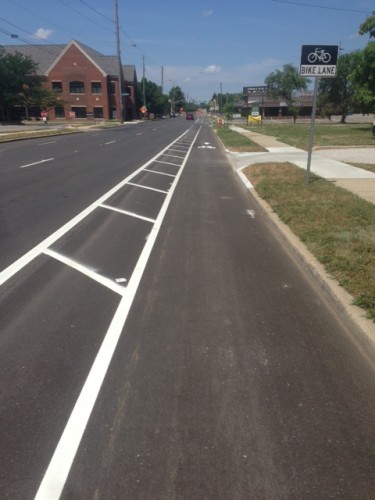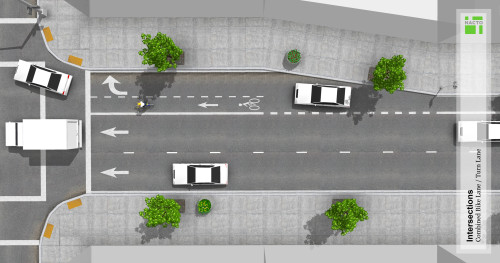If you have traveled the stretch of Illinois Street north of 16th street that is being repaved, you have undoubtedly observed that new lines have been painted on the new pavement. We previously reported that this would be the site of Indy’s first buffered bike lane and true to that, the new striping reflects that!

Jamison Hutchins, Bicycle & Pedestrian Coordinator with DPW, sent along this image today showing what to expect north of 22nd street (all the way to 32nd) once work is completed on the bridge over Fall Creek sometime next year.

According to Jamison, there will be some changes to the intersection treatments as well. He sent along an image and had this to say,
“…note that we switched the majority of the intersections to the shared right turn lanes as opposed to the old configuration that caused a lot of heartburn to riders and drivers.”
Although it will be some time before Illinois Street will reopen to automobile traffic, it is nice to see what riders have in store once the street is back to normal operating service.
What a horrible, brainless idea. This removes travel space for cars. Roads are for car travel, not bicycle travel, and putting cars and bicyclists near each other will get bicyclists killed. In the same way that some cities have built busways, dedicated bikeways are the best option for bicycle travel.
Obvious, I can’t tell if you’re trolling or serious.
Seriously trolling.
From the image above and the comment from Mr. Hutchins, it appears that they are eliminating the terrible design element whereby the bike lane is required to criss cross with the right travel lane when it, inexplicably to many drivers, becomes a right turn only lane. It’s hard to judge too much overall from just one image, but this should be a major improvement.
On the downside, I’m not a big fan of losing more on-street parking (not sure if that is what’s occurring to create the buffer from cars. Even though it might not be highly utilized today, it could be needed with redevelopment, it helps calm traffic, and it makes for a more pleasant walk on the sidewalk.
I’ve ridden my bike on that lane 3-4 times per week ever since it was installed. Thank God the pavement has been resurfaced! What an unholy mess it was. Crossing my fingers that Capitol will be next.
The separated lane is certainly an improvement. I’m a bit concerned about creating a “free for all” between bikes and cars in the right turn lanes, but I’ll withhold judgement and see how it shakes out.
Nobody should get heartburn about the parking spots that were eliminated. In 7 years of working at Methodist hospital I’ve never EVER seen a car parked in any of those spots. Not once.
The bridge will be reopened NEXT YEAR!? (head explodes)
You’ve never seen a parked car on Illinois north of 22nd in 7 years? Somehow, inexplicably, you must have never cycled by Stuart Mortuary during a funeral. Depending on the popularity of the deceased, an entire block (or more) of on-street parking is used.
Hell, you can bring up Google maps right now and see two cars parked on Illinois in front of Stuart. I can’t imagine they’re pleased about this parking having been eliminated. North of Stuart, I’ll admit that there is no current need, nor much possibility of future need for on-street parking on that side of Illinois.
And I’ll have to look more closely tomorrow, but I’m pretty sure the buffered lane actually begins at 21st St. If I’m right this concerns me, because the block bounded by McLean-Illinois-22nd-Meridian has long-term potential to be a neighborhood-draw retail center. The on-street parking lane along Illinois would have provided a not-insignificant number of parking spaces to support that (probably 15 or so).
Confirmed: the buffered lane begins at 21st.
On further review, in fact, the photo provided for this post is showing the 2100 block of Illinois. The red brick building on the left is the Hamilton Center at 2160 N Illinois.
I stand corrected. Granted, I only see the street on my way to and from work. Shortsighted comment on my part.
Side note: the Fall Creek bridges are National Register listed. They must be restored, not replaced.
Most of them have cut limestone facing over poured concrete arch construction (though Central Avenue is an old-style rubble-filled stone arch bridge, given to spectacular failure).
Looks great. Indy is great for getting around on a bicycle. Here the asphalt looks good for northbound if not too many motorcars. The sideride looks good too if car traffic gets too hairy or going southbound or at night. Looks like new concrete on the sideride, glad to see them keeping it smooth.
Does anyone here regularly commute on Illinois via car? How much has your commute been inconvenienced, if at all?
I sometimes commute on this stretch by car, and I can say, for me, it’s been a mild inconvenience *at most*. My wife would normally take Illinois Street every day at rush hour, but she has adapted without complaint.
I’m reminded of this article: If You Can Repeatedly Close a Freeway For Months At a Time, Do You Really Need It At All? (http://www.urbanophile.com/2013/06/30/if-you-can-repeatedly-close-a-freeway-for-months-at-a-time-do-you-really-need-it-at-all/)
I’ll paraphrase and ask, if Illinois Street can be closed for months at a time, does it really need to be one-way?
My girlfriend’s normal commute involves Illinois St on a regular basis (56th/Illinois to Georgia/Meridian). The ride in is unchanged as she takes Capitol, but the ride out is now a bit longer due to the additional traffic on Meridian.
Usually, most Illinois St traffic is for those commuting to the Meridian-Kessler, Broad Ripple, Nora areas, while much of Meridian St is Carmel commuters.
It’s not enough of an inconvenience that she wants to pull her hair out, but it’s definitely noticeable and enough that I hear about it when I get home at 5:30.
All the more reason to keep pushing her to ride into work. 🙂
Great point Chuck. I would opine that it does not need to be one-way. Much like the periodic closures or reductions to one lane on New York & Michigan on the east side over the past few years has shown that they need not be one way either.
Paul, I definitely agree.
North of 38th, Illinois is a quiet two-lane road where bikes, pedestrians, and cars co-exist pretty peacefully.
South of 38th, it’s pretty treacherous for a bike as cars are cruising near 50mph including buses and trucks.
There’s just as much traffic at 32nd (one-way) as there is at 49th (two-way) and both seem to flow at about the same rate.
According to MPO traffic counts, traffic on Illinois both ways at 49th is only 52% of the one-way traffic at 32nd. It’s not the same, it’s far less busy.
Illinois and Capitol are much quieter streets north of 38th, partly because both are still 4 lanes wide there and there is less through traffic. Part of the quiet also comes from fairly long residential setbacks, and a massive tree canopy. Finally, both streets function as secondary (neighborhood) arterials there.
South of 38th they are primary arterials and carry about as much traffic combined as Meridian…but they are busiest at their respective rush hours, Capitol in the morning and Illinois in the afternoon. Meridian’s traffic is pretty even throughout the daylight hours.
My daughters will be starting at School 60 near 33rd and Pennsylvania in a couple of weeks so this will be my commute (both by bike and by car) in the near future. I’m very excited to use these lanes pretty much all the way up to the school.
As for the parking, I’m sure the funeral home will adjust and if that is the only/main use of parking along that stretch, good riddance. If they happen to replace the parking at some point in the future, I would highly recommend they go with the “driving lane, parking, bike track, sidewalk” configuration to continue to give bikes more protection and further remove foot traffic from car traffic.
The city should follow the combined turn lane model and redo the Allisonville bike lanes at the intersections. Having the bike lane end at every intersection and then restart again is a joke. Apparently the combined turn lane works on Broad Ripple Ave otherwise it would not be going in on Illinois St.
I agree. I think that the former “crossing the lanes” version that was on Illinois before creates more of a conflict (imagine a pair of car lanes crossing – instant road rage and confusion). Instead this combined design is more akin to a lane merge which most people can manage fairly well.
We need a lot more inhtgsis like this!
Now if we can just get the …arrogant and impatient drivers to obey traffic signs and signals, I’ll be happy. I have suggested to DPW that the signage for left turns on green arrow be like this.
[traffic signal][circle red ntor sign][left on green arrow sign]
This would let drivers first find the traffic signal controlling their lane, and then (reading left to right) see the NTOR sign before they get to the left on green arrow sign.
Then again, this makes too much sense, and “our friends” at DPW think that placing NTOR signs on the left side of traffic signals controlling right turns is a “best practice”.